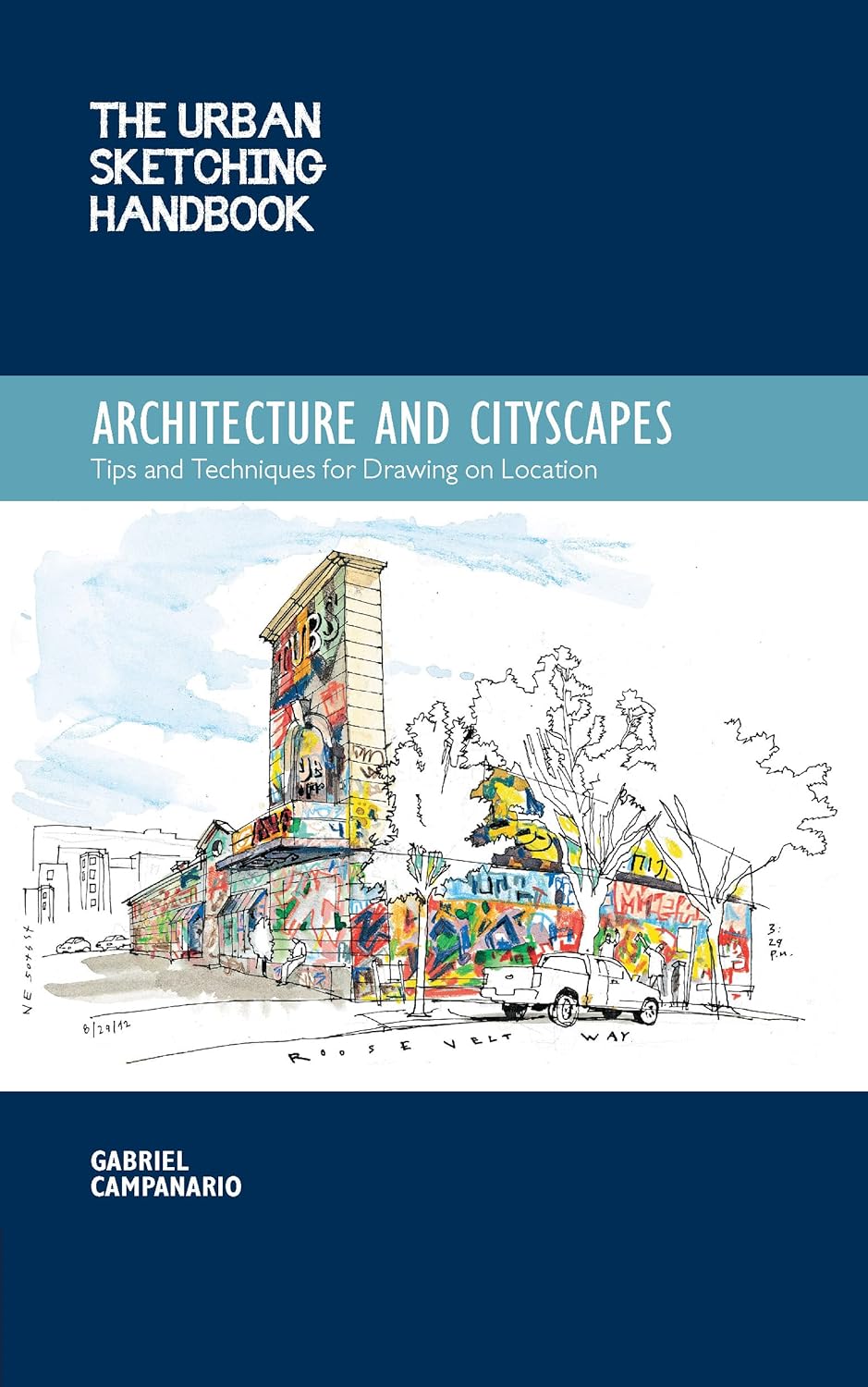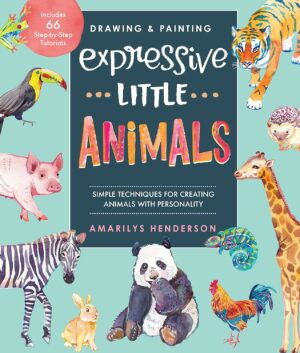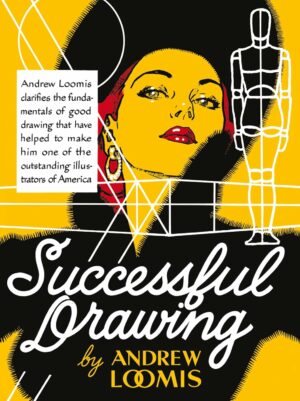Award-winning illustrator Gabriel Campanario first introduced his approach to drawing in The Art of Urban Sketching, a showcase of more than 500 sketches and drawing tips shared by more than 100 urban sketchers around the world. Now, he drills down into specific challenges of making sketches on location, rain or shine, quickly or slowly, and the most suitable techniques for every situation, in The Urban Sketching Handbook series. It’s easy to overlook that ample variety of buildings and spaces and the differences from city to city, country to country. From houses, apartments and shopping malls to public buildings and places of worship, the structures humans have created over the centuries, for shelter, commerce, industry, transportation or recreation, are fascinating subjects to study and sketch.
In The Urban Sketching Handbook: Architecture and Cityscapes, Gabriel lays out keys to help make the experience of drawing architecture and cityscapes fun and rewarding. Using composition, depth, scale, contrast, line and creativity, sketching out buildings and structure has never been more inspirational. This guide will help you to develop your own creative approach, no matter what your skill level may be today. As much as The Urban Sketching Handbook: Architecture and Cityscapes may inspire you to draw more urban spaces, it can also help to increase your appreciation of the built environment. Drawing the places where we live, work and play, is a great way to show appreciation and creativity.
Read more
296 reviews for The Urban Sketching Handbook Architecture and Cityscapes: Tips and Techniques for Drawing on Location (Volume 1) (Urban Sketching Handbooks, 1)
Add a review

Original price was: $18.99.$14.39Current price is: $14.39.








ME anne MARIE –
Très bonne progression dans les exemples choisis.Très complet. Très beaux croquis. Je suis ravie car ce livre correspond parfaitement à mon attente.
Cristian –
Me encanta esta colección de libros. Son muy prácticos para aprender o mejorar las técnicas.
L. Huls –
I can only second the glowing reviews above. Just AS beautiful as The Art of Urban Sketching with useful technique. It IS, however, extremely difficult to read because the font is very small, very thin and printed lightly.
Protyush Lala –
Liked the book
good illustrations. Simple methods. Good tips.
Suzanne Tractenberg –
I highly recommend this for many levels of US expertise. I also recommend Suhita Shirodkar’s ‘Techniques for Beginners’. And feel all levels would benefit from her tips.
jack khouri –
Must read. Great book in fact the whole collection is highly recommended. To the point and a great approach to improving your skills
RitterH –
Great book with samples and simple, clear directives to guide you to sketching. Some of the books I have viewed just have sketches in them without actual sketching guidance.
Also, even though I can not draw that well I like ot riffle through the book to read and observe various urban sketching techniques.
I ordered the author’s other book on sketching people. Highly recommend it.
Cliente de Amazon –
Me encanto el producto! Excelente!
Curly Girl –
This book did not disappoint…same high quality as the others in the USk series. Received it a day after promised arrival date, but worth the wait.
Horatio –
Tremendous value for money with so many differing sketch examples, subjects, finishes, treatments and ideas collected from active sketchers from all over the world. Gabriel Campanario is generous and inspiring in sharing his techniques, ideas and suggestions – if you only ever buy one book on sketching – this is it!
Calvin Durham –
I love every one of the books in this series. Haven’t run across a bad one yet. I keep them on my desk and refer back form time to time. Very useful and I love the size of the book. Easy to pick up and throw in your bag and thumb through as time allows.
Tina K. –
Unlike The Art of Urban Sketching, Gabriel Campanario’s first book, which is a huge, coffee-table gallery of sketches from around the globe, The Urban Sketching Handbook: Architecture and Cityscapes – Tips and Techniques for Drawing on Location is a compact manual of key principles that are essential to fully expressing oneself when sketching on location. It’s an ideal companion piece to the Art of Urban Sketching’s inspirational eye candy.
The six principles – composition, scale, depth, contrast, line, creativity – are illustrated with Campanario’s sketch examples as well as those of many urban sketchers worldwide who exhibit a vast range of styles and media. Each of the book’s sections presents direct and practical information as it relates to architectural and street sketching along with an example to illustrate each concept. For example, in the section on composition: apply the rule of thirds; use thumbnails to plan; choose interesting formats.
The book’s sixth key, creativity, encourages the reader to push beyond simply rendering a building to finding one’s unique style. “Developing your own drawing style takes time. Be patient,” Campanario urges. “You risk not finding it if you give up too soon.” The last section is a slim gallery of works organized by media by artists well-known in the urban sketching community.
Campanario’s personal approach and attitude toward urban sketching and toward drawing as a form of personal expression are apparent throughout. “A line made with assertion, even if it’s in the wrong spot, is worth a thousand marks made with hesitation,” he says. He encourages sketchers to engage with interested bystanders who comment on your sketch. “Urban sketching is about immersing yourself in your city or the places you travel. You’ll miss out if you wear headphones or don’t welcome interaction.”
To a would-be urban sketcher who has never even touched a sketchbook, I might not recommend this as a first reference, as there’s no information about tools and materials or practical suggestions (bring a hat and stool!) for on-site sketching. (To those folks, I might recommend James Hobbs’ Sketch Your World, which is a more comprehensive guide on how to become an urban sketcher.) For all the rest of us, though, Architecture and Cityscapes is a handy, compact volume small and thin enough to throw into our sketch bags. (It even has an elastic band to look like a Moleskine and a few blank pages inside to sketch on!)
Pat Loughery –
Seattle’s Gabriel Campanario is well known as the Seattle Sketcher whose work is published in the Seattle Times newspaper, giving us artistic looks at life in and around the city.
This handbook, the first of a pair, is a brief but helpful look at sketching architecture and cityscapes. It’s creative, simple and straightforward enough for new sketchers but useful for more advanced creatives.
Perhaps the most helpful page is 111, which lists the 40+ contributing artists and their own sites. It will be very useful to go look through their work as I continue to practice my own urban sketching.